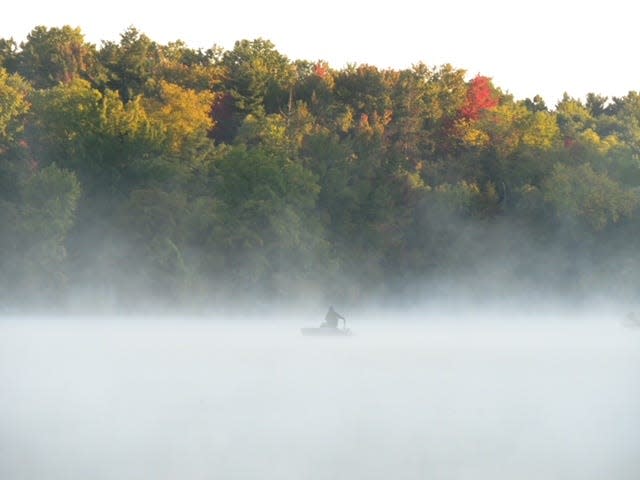History hunters – how Bugs Bunny changed the meaning of ‘nimrod’
What do Findley State Park, the word “nimrod” and Elmer Fudd have in common? More than you might think. Certainly, more than I would have imagined.
What started months ago as a road trip to Beaver Creek State Park in eastern Ohio has morphed into historical research with a side trip into etymology. Which led to Elmer Fudd.
Like most places I go these days, you can’t get there from here. So it’s best to go back to the beginning. In February, I set out on a three-day road trip through Eastern Ohio with stops at Beaver Creek State Park, a public art installation in Wellsville and the Towpath Trail Peace Park outside of Bolivar.
The trip was driven by serendipity from the start, actually a few days before that. My itinerary was inspired by a chance meeting with a reader − a guy I’d never met before − in the parking lot of Wedgewing Restaurant in Perrysville. We got to talking about canoeing and rivers and he suggested I try Beaver Creek.
So I did. What followed was a trip marked by coincidences and unexpected connections spanning time, space, and the human condition. And it didn’t end when I got back home, unpacked my camping gear and put my canoe away. Which brings us to the subject of this column.

Perfect timing and 40, not 100, miles from home
While I was doing research for my columns on the Beaver Creek trip − getting background and conducting online interviews − Nikki McConnell contacted me via text message. An old acquaintance from my days at the paper, she now works at Findley State Park. She’d read the first of my columns on the Beaver Creek trip.
“Ironically the naturalist and park manager from Beaver Creek will be at Findley on Wednesday,” she wrote in a text message. “They're going to help us out for the eclipse since their park is not in the path of totality.”
Her timing was perfect. I’d wanted to interview someone from Beaver Creek State Park to get more background for my column. Findley State Park is about 40 miles from home; Beaver Creek is more than 110 miles.
I was tempted to ask her if she’d consider instigating an arm-wrestling match between the naturalist and park manager, zip-tie their arms together and keep them there long enough for me to drive up and interview them. That seemed a bit unprofessional, so I asked her for their contact information instead.
Ultimately, I contacted Beaver Creek State Park manager Karl Mattern for an email interview. His input − and a few photos he sent − made for a much better story for my column.
Findley State Park: Came to be because of a judge and his wife with a connection to Ashland County
Fast forward to last week when Nikki offered me a chance to return the favor. She’s working on a history wall for Findley State Park and asked me to go over the copy she’d written. So I did. It didn’t take long, mainly because the park’s history is straight-forward. One of Ohio’s first state parks, Findley is the result of the stewardship and generosity of Common Pleas Judge Guy B. Findley and his wife, Jennie.
In the late 1930s, the couple donated the land to the state for public recreation after reforesting it with the help of an all-Black division of the Civilian Conservation Corps that was headquartered in Elyria. Originally known as Findley State Forest, the 900-acre site became Findley State Park in 1950.
The judge grew up in Sullivan Township in Ashland County. He developed a deep appreciation for the outdoors as a place for recreation and contemplation. He had been an avid hunter all his life.
Enter the true definition of nimrod, until Elmer Fudd came along
Serendipity, once again, came into play in correspondence between Nikki and me during the rewriting process. From her I learned Judge Findley truly was a nimrod. Not in the negative sense of the word. For thousands of years, if you were called a nimrod, it meant you were regarded as a skilled hunter. Till Elmer Fudd came along.
The great-grandson of Noah, Nimrod is referred to in the Bible as a “mighty hunter before the Lord.” He also proved to be a thorn in the Lord’s side for his rebellious streak, which led to the construction of the Tower of Babel.
Apparently, in the mid 20th century, “nimrod” took on a whole new meaning − after Elmer Fudd’s nemesis, Bugs Bunny, sarcastically referred to him in a cartoon as a regular nimrod.
Bugs Bunny’s derogatory connotations stuck − at least in North American popular culture.
Nikki brought this bit of etymology to my attention during our email exchanges. Apparently, we share an interest in word origins.
Serendipity, etymology and another judge connection
Which brought up another bit of serendipity. My interest in etymology took root during my post-secondary education. After graduating from West Tech High School in 1970 with a major in vocational horticulture, I pursued a liberal arts education that involved spending hours at the Eastman Branch of the Cleveland Public Library − poring over books on grammar, literature, and word origins.

The library originally occupied a former storefront at Lorain Avenue and West 115 Street. Ironically, it was catty-corner to the Cleveland Christian Home for Children, a former orphanage where Judge Findley once served as a trustee.
I’m looking forward to seeing Nikki’s history wall. Even if it doesn’t include references to Elmer Fudd, Bugs Bunny or nimrods.
This article originally appeared on Ashland Times Gazette: History hunters – how Bugs Bunny changed the meaning of ‘nimrod’

